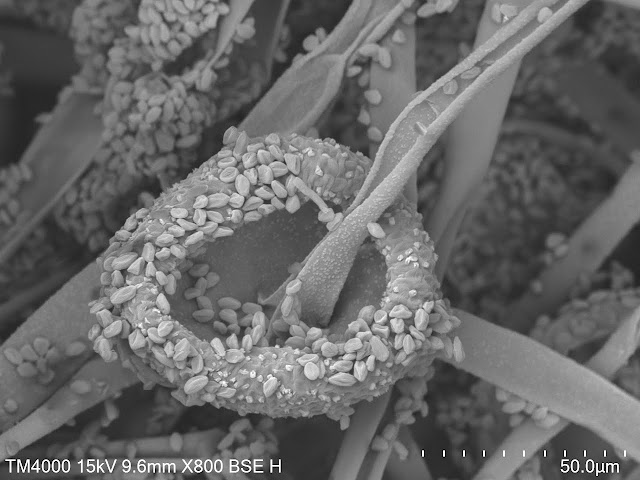You may have heard of (and eaten) tempeh - an Indonesian fermented soy product - high in protein and very delicious. Cooked soybeans (sometimes also other beans) are bound into a cake by a culinary mold called Rhizopus Oligosporus. The mold grows on the beans and pre-digests them, producing a range of flavorful compounds.
Looking at a piece of tempeh, you'll see the beans bound together by the beautiful white mycelium of Rhizopus Oligosporus, which consists of all the microscopic threads (called hyphae) of the fungus. That's very similar to the smooth white surface of a camambert or brie cheese. But at a microscopic level, there is much more to see!
This scanning electron microscope (SEM) image shows the growth of the hyphae, forming a dense net. Things get more interesting when the fungus starts to sporulate, meaning that it forms spores, like microscopic seeds, for asexual reproduction. (As this affects the taste of the tempeh, fermentation is usually stopped before the fungus reaches this stage.)
As you can see in this image, many small spore heads (sporangia) are formed.
Taking a closer look, each spore head is formed like a tiny mushroom, with the spores sitting on the surface.
Here is a spore head at an early stage of formation, without any spores on it yet. Later, it will be fully grown and covered with spores like these ones:
You may have noted how spores seem to be everywhere in these images - they have been dispersed from the spore heads in the hope to find a new place to grow.
Finally, some more technical information:
The images were taken using a Hitachi TM4000 tabletop scanning electron microscope, part of the Lund Nano Lab. For preparing the samples, small pieces of tempeh were dried at room temperature, and 10 nm of platinum/palladium (Pt/Pd) alloy (80/20) was sputtered as a conductive coating (which is necessary to obtain good SEM images of non-conductive samples).
I've grown the tempeh on soybeans using the starter from topcultures.com, incubating for 24 - 36 h in a water bath setup inspired by the books The Art of Fermentation and Miso, Tempeh, Natto & Other Tasty Ferments.
I'd like to thank Lund Nano Lab and NanoLund for enabling this project by supplying the necessary equipment.
I hope you enjoyed this post and would be happy if you get in touch by sending me an email (kojimaker [at] gmail [dot] com).









